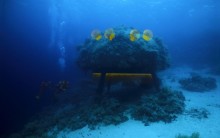Liquid Door, the first solo exhibition in the U. S. by artists Hilario Isola and Matteo Norzi, has many moving parts, but a permeable membrane, the liquid door is its center piece. The liquid door refers to the fragile interface which unites man with the sea, namely, a surface between air and water, formed by the air pressure present in an underwater dome called the Starfish House as realized by Jacques Cousteau in 1965 as an experimental underwater dwelling.
Isola and Norzi pay homage to the Cousteau and six crew members known as “oceanauts” in a multi-faceted archaeological exploration of the roles of human imagination, storytelling, and fiction in creating meaning through the Liquid Door project, rooted in a 1995 cargo ship journey the artists made to Alexandria, Egypt. While the “real show” took place at a tank in the New York Aquarium, a living, albeit fabricated environment which stands for a conceptual looking glass, Art in General recently hosted an opening for an exhibition which featured Cousteau’s documentary film Le Monde Sans Soleil, coincidentally reclaimed by the Italian artists in an East Village bookstore. The film treats audiences to scenes of domesticity which play out in the Starfish House which include the oceanauts enjoying multi-course meals and cigarette smoking.
Additionally, the exhibition included archival, C-prints from the Coney Island Aquarium with images of Norzi submerged in the aquarium outfitted with a sculpture representational of the liquid door, an acrylic aquarium, and other “relics”. Princeton Professor D. Graham Burnett gave a talk about the historical context of exploration in the 1960’s when there was debate about whether the future of self-contained living environments would be underwater or in space.
The New York Aquarium will feature a Liquid Door Tour on May 25, 2010 for members. Ultimately, the art project will recreate such a door on the very site where it started, aboard the ruins of the Starfish House, situated on the floor of the Red Sea.







 RSS
RSS
